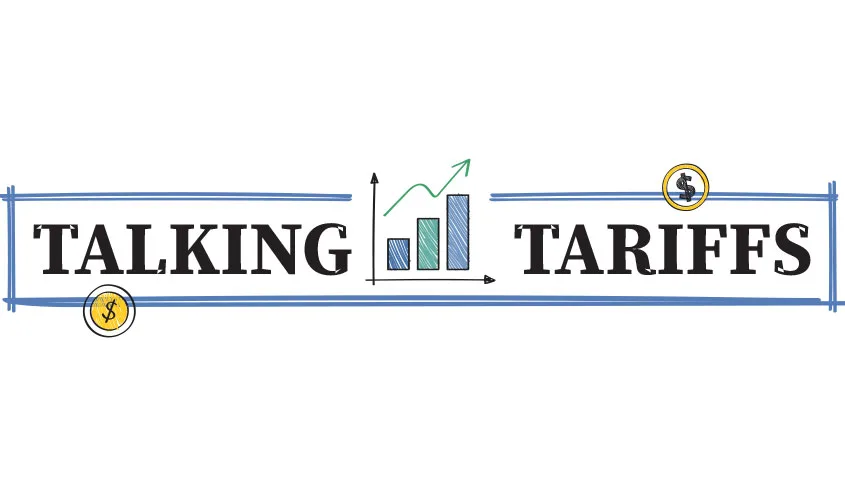Let’s just get this out of the way: This article is not meant to sway your political view of tariffs, or of the people who champion their use. Whatever your politics may be, I think we can all agree that tariffs are a sign of a problem; have been an oft-used, blunt instrument of economic nationalism; and have been blamed for triggering global financial upheavals over the course of centuries.
Think of tariffs the way you would, say, solitary confinement of prisoners: a controversial tool that some would argue does more harm than good, but nobody is going to argue it out of existence in the near term. Like anyone, I have my opinions, but for the purpose of this article, I am neither defending nor condemning their use — just inviting you to think of them a different way.
We’re going to focus on the tariffs the U.S. and China are imposing on each other, although I could also apply most of these points to other countries.
It should be obvious why this subject finds itself in a toy-focused trade magazine, but in case it’s not, a huge percentage of the toys sold in the U.S. continue to come from China. The addition of toys to the list of goods scheduled to be tariffed beginning in December has inflamed the debate about tariffs because, well, who wants to see price increases on toys?
Historically, national governments have used tariffs to protect domestic industries from foreign competition, typically from competitors who either enjoy a production cost advantage or who have chosen to underprice goods in a certain sector. The cost advantages are typically the result of lower relative wages, but they can also be related to technological advantages or simply the willingness to sell certain products below cost for a period of time to build market share (i.e., “dumping”).
Tariffs have sometimes been used on a temporary basis to allow domestic industries in the country imposing the tariffs to adjust to economic conditions that fell into disequilibrium. This “protects” the domestic business while it has a chance to modernize, or until the labor cost advantage of the target country dissipates through market forces. One example from the ‘70s was putting tariffs (and quotas) on imported cars, as models made in Japan at a lower cost were eroding the competitiveness of the U.S. auto industry. The U.S. auto makers responded over time by modernizing processes (to reduce the disadvantage of higher labor rates), and the Japanese got around the tariffs and quotas by increasing production in the U.S. It was sort of a win-win.
“I am neither defending nor condemning [tariffs’] use – just inviting you to think of them a different way.”
Countries also use tariffs to protect domestic industries deemed to be strategically vital, such as steel, or vital to the cultural integrity of the country imposing them. Think of the high tariffs the French put on imported U.S. wine while protecting its domestic producers with subsidies.
You get the idea: Tariffs have historically been used to protect domestic industries from foreign competition. Several aspects of the tit-for-tat tariff slapping that has marked U.S.-China trade relations in the past couple of years are different from what we have seen historically. Nobody can make a credible case that imposing tariffs on products, such as toys, will protect U.S. toymakers, since there is so little toy production here. And China is not likely to boost the fortunes of its own soybean producers by hitting U.S.-grown soy beans with tariffs because Chinese growers would meet the demand if they could.
What makes these tariffs different — and so much more controversial — is that they are being used as punitive measures in response to other transgressions, both real and imagined, that will not actually be directly remedied by the tariffs. These tariffs will not protect any industries or return any jobs, but we’ll show “those guys” we mean business about stealing intellectual property.
But is it that simple? Let’s look at this a different way. Let’s agree that these specific tariffs are probably motivated by factors that go beyond preserving domestic industries and adding American jobs. But that doesn’t mean there isn’t at least some economic justification for wanting to level the playing field. Even if we put aside the huge issues that these tariffs are meant to put on the negotiation table (intellectual property theft, forced technology transfer, opaque disclosure, etc.), the fact remains that America has a huge trade deficit with China, primarily because of a massive gap in wages.
When I was in business school a generation ago, we had a guest lecturer in our business, government, and international economy (BGIE) class — and, yes, we pronounced it “biggie.” He was an official at one of the nation’s largest labor unions, and his message that day in 1985 was that by outsourcing our production to countries with far lower average labor rates, the U.S. was, in effect, importing a reduction in our standard of living. He went on further to say that the only real competitive advantage that these countries enjoyed was (and I quote), the “abject poverty of its citizens,” and that if we continued to increase our purchases of products made in these countries, rather than those made in the U.S., we were basically importing this abject poverty.
Fast forward 35 years. We haven’t seen America become a nation mired in abject poverty, but we have seen manufacturing wages in the U.S. remain basically flat over the past 40 years when adjusted for inflation, while real wages in China have soared exponentially during that period. Similarly, many other low-cost manufacturing hubs have seen wages surge. From a global perspective, this is good, right? Hundreds of millions of people have been lifted out of abject poverty by rising wages, and Americans have enjoyed extremely low average rates of inflation over this period. But the standard of living in those other countries has risen much faster than it has in the U.S.
Many years ago, I studied inflation in the toy industry and concluded that the rise in Walmart’s market share of total U.S. toy sales during the ‘80s through the early ‘00s was one of the biggest contributors to the low rate of toy price inflation in this country during that period. But behind that story, of course, is the increase in toys coming from low-labor-rate countries, especially China.
Over the course of the last decade, wage rates in China continued to rise (less so recently), and the country’s labor rate arbitrage advantage has eroded. Long before anyone in the toy industry worried about a “tariff tweet,” U.S. marketing companies were already exploring how to reduce production costs by moving out of China because of how (relatively) high Chinese wages had risen.
So, what if we think of these tariffs as advance payments on future manufacturing costs? We may not be creating or saving American jobs with these tariffs, but we are getting a look at the inevitable outcome of powerful market forces. What if, instead of seeing them as punitive measures against a repressive, kleptocratic nation that micro manages its economy and where U.S. companies are innocent bystanders, we saw them as relatively inexpensive reminders of the inevitability of capitalism, even if some of the players are backed by states?
“What if, instead of seeing [tariffs] as punitive measures, … we saw them as relatively inexpensive reminders of the inevitability of capitalism?”
If China didn’t run a massive trade surplus with the U.S., there would still be other issues compelling the current administration to act, but it would be harder to support the move with deficit data. So, let’s just say this is a purely economic move designed to allow domestic companies some time to lower their manufacturing costs.
They probably wouldn’t do that by bringing production back to the U.S. anytime soon (although some toy categories with highly automated production and high shipping costs have already seen increases in domestic production). But they probably would — and have already begun to — look for production in lower cost regions. I’ve written in the Toy Book before about other potential sources of low-labor-rate production (Vietnam, Indonesia, rural India, and many spots on the African continent). None of these locations can hope to rival China for overall attractiveness yet, when considering transportation infrastructure, manufacturing experience, and sheer scale. But collectively, they represent the future.
Regardless of the tariffs on products made in Chinese toy factories, the fact is that the owners of those factories would rather be making higher-value products. They’d rather have their workers be trained in how to assemble electronic products, medical devices, or any other products with high wholesale prices so that their fixed costs could be better leveraged. Makes sense, right? You’d rather sell a $50 talking doll than a $5 mini doll, if you had a choice. That means that these factories, over time, will price their services at higher levels.
The abruptness of these tariffs is disruptive, no doubt. And the sophomoric way these policies are being formulated and disseminated via tweets is embarrassing. But a 15% tariff on toys might just make the product cost as much as it will in a few years anyway if wage rates continue to rise. Why not just think of the tariff as a bill delivered from the future that is coming due now? It won’t help with profits over the next 18 months, but it may spur companies to take actions they should be taking anyway. The increasing frequency of coastal hurricane flooding can remind us that maybe we shouldn’t be building expensive homes on sand bars. Similarly, maybe if we de-politicize the tariff discussion, we can see it as a call to look several chess moves ahead and take actions now that will pay off down the road.
This article originally appeared in the September/October 2019 issue of the Toy Book.



